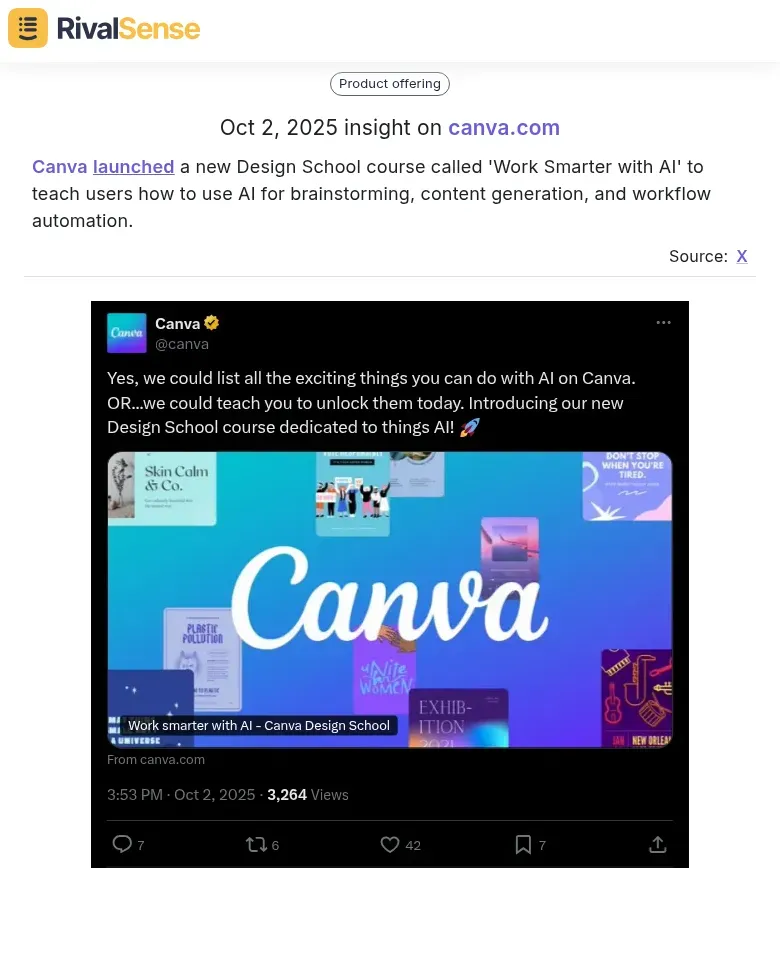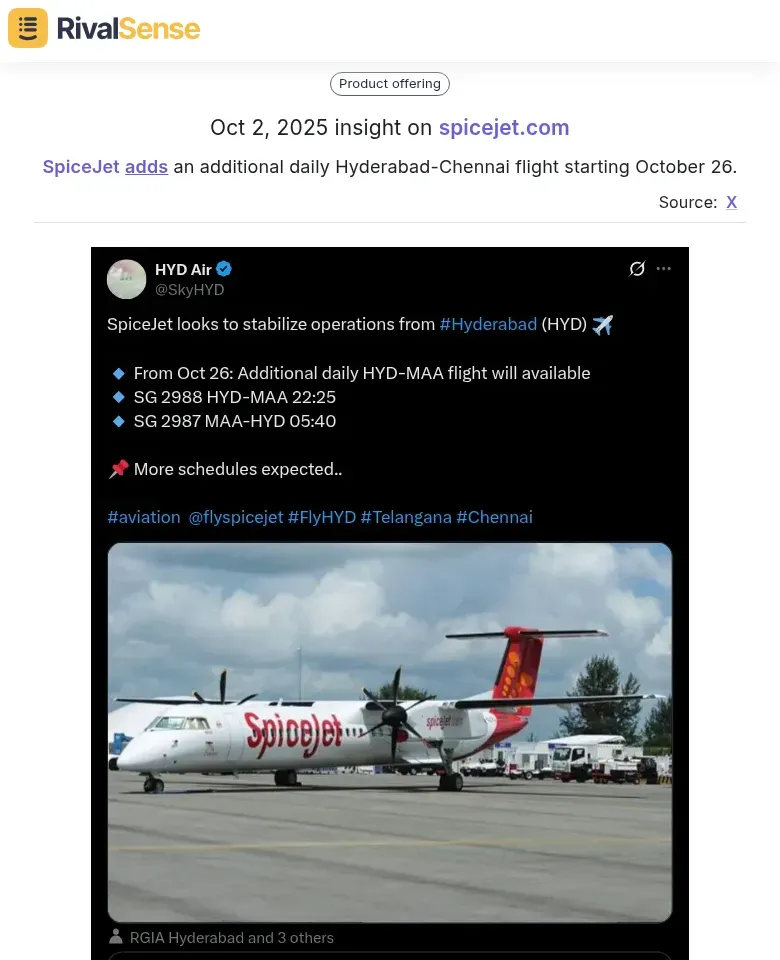Competitor Analysis: Uncover Strategic Insights from Product Launches and Expansions
Competitor analysis transforms social listening into strategic intelligence for any business. By tracking competitor announcements in real-time, you gain immediate insights into their product roadmap priorities, feature launches, and market positioning. This isn't just about monitoring—it's about anticipating industry shifts before they become mainstream, allowing you to stay agile and responsive.
When competitors announce new features or expansions, they reveal their strategic focus areas and responses to customer demands. These real-time updates expose emerging market trends and help you understand what customers truly value. For instance, if multiple competitors suddenly emphasize AI integration or geographic expansion, it signals broader movements you can't afford to ignore.
Practical steps to get started:
- ✅ Create a dedicated list of key competitors and industry leaders across platforms
- ✅ Set up alerts for product launches, feature updates, and strategic announcements
- ✅ Monitor engagement metrics to gauge market reception and identify gaps
- ✅ Track relevant hashtags and topics to spot trends in your industry
- ✅ Analyze timing patterns to understand competitor release cycles and plan accordingly
This approach helps you anticipate customer expectations, identify feature gaps in your offerings, and make data-driven decisions about your product roadmap. Turn competitor noise into actionable competitive intelligence that drives growth.
Analyzing Product Feature Launches and Innovations
Monitoring competitor product feature launches is essential for spotting innovation trends and staying competitive. These announcements often highlight strategic shifts and customer needs, giving you a window into the future of your industry. By analyzing these moves, you can adapt your own offerings to meet evolving demands and avoid being left behind.
For example, tracking feature launches helps you understand how competitors integrate emerging technologies like AI. Consider how RivalSense detected that Canva launched a new Design School course called 'Work Smarter with AI' to teach users how to use AI for brainstorming, content generation, and workflow automation. This type of insight is valuable because it reveals how competitors are educating users on AI adoption, signaling a trend toward AI-driven productivity tools that you might need to incorporate into your strategy.

Practical steps for tracking features:
- 🔍 Use tools like RivalSense to automate monitoring of competitor feature launches and updates
- 📊 Create a benchmarking checklist: identify key competitors, set feature benchmarks, analyze gaps, and prioritize development based on user demand
- 🚀 Focus on solving real customer problems rather than chasing every trend to avoid feature bloat and maintain product clarity
By systematically tracking innovations, you can identify opportunities for differentiation and ensure your product remains relevant and compelling.
Gaining Insights from Expansion and Route Announcements
Expansion and route announcements provide critical intelligence on competitor growth strategies and market confidence. These moves often indicate where demand is rising or where competitors see untapped potential, helping you refine your own geographic or service expansion plans. Analyzing these announcements allows you to anticipate market shifts and protect your core markets from incursions.
For instance, when competitors launch new routes or increase frequency, it signals operational scalability and customer demand. RivalSense insights like British Airways boosting Middle East connectivity with additional flights from Bahrain, Abu Dhabi, and Saudi Arabia to the UK and SpiceJet adding an additional daily Hyderabad-Chennai flight starting October 26 demonstrate this. Tracking such expansions is valuable because it helps you identify new market opportunities, assess competitive threats in real-time, and adjust your logistics or service offerings to match or counter these moves.


Actionable steps for analyzing expansions:
- 🗺️ Monitor competitor press releases, regulatory filings, and industry news for expansion updates
- 📈 Map new routes or services against market data to identify underserved areas or growth hotspots
- ⚖️ Assess your operational scalability—can you match competitor frequency or explore similar opportunities?
- 🛡️ Adjust your strategy by reinforcing vulnerable markets or launching preemptive initiatives to maintain competitive edge
This proactive approach ensures you're not caught off guard and can capitalize on emerging trends in dynamic industries.
Extracting Strategic Lessons from Competitor Moves
Moving beyond individual features, extracting strategic lessons from competitor behavior reveals broader industry patterns and long-term visions. This deeper analysis helps you understand the 'why' behind competitor actions, enabling you to adapt your strategies for sustained competitiveness. By identifying recurring themes, you can anticipate future moves and align your business with evolving market expectations.
For example, if competitors consistently focus on privacy enhancements or decentralized models, it may indicate a industry-wide shift toward data ownership and user trust. Analyzing patterns in onboarding processes, partnership announcements, or technology adoptions can uncover strategic priorities that you can integrate into your own planning. This turns specific competitor actions into general strategies that keep your business agile and forward-thinking.
Practical steps for strategic extraction:
- 📅 Document competitor feature launches, expansions, and other moves monthly, categorizing them into themes like innovation, retention, or scalability
- 🧠 Hold quarterly cross-functional strategy sessions to brainstorm implications and derive actionable insights
- 🔄 Conduct regular SWOT analyses to identify gaps in your offerings and avoid market blind spots
- 💡 Ask critical questions: What problem does this move solve? Why is it happening now? How does it fit into their long-term vision?
By consistently analyzing competitor behavior, you can refine your competitive positioning and make informed decisions that drive growth.
Practical Steps for Implementing Competitor Insights
Implementing competitor insights effectively requires a structured approach to ensure they translate into tangible business improvements. Start by setting up automated systems to capture real-time data, then integrate findings into your operations, and finally measure the impact to refine future actions. This cycle keeps your business proactive rather than reactive, turning intelligence into advantage.
First, leverage tools like RivalSense to track competitor announcements, pricing changes, and feature launches automatically. Set up keyword alerts for your product category and competitor names, and create a centralized dashboard for team access. This ensures everyone stays informed and can act quickly on new information.
Next, integrate insights into your product roadmap and marketing strategies through regular cross-functional meetings. Involve product, marketing, and sales teams to review updates and prioritize responses. For instance, if a competitor launches a new integration, accelerate your own development or highlight superior features in campaigns.
Checklist for implementation:
- ✅ Define clear KPIs such as user adoption rates, customer satisfaction scores, or market share shifts to measure impact
- ✅ Use A/B testing to compare performance of new features or strategies against previous versions
- ✅ Analyze data post-implementation to refine decisions and ensure responses are data-informed, not just reactive
- ✅ Foster a culture of continuous learning where competitor insights drive innovation and agility
By following these steps, you can build a responsive strategy that leverages competitor moves to strengthen your market position.
Ready to take your competitor analysis to the next level? Try RivalSense for free and get your first competitor report today to start uncovering actionable insights that drive your business forward!
📚 Read more
👉 Competitor Tracking Mastery: Real-World Lessons from Korean Air for B2B Leaders
👉 Gain a Strategic Edge: Track Competitor Media Mentions and Executive Moves
👉 Unlocking Strategic Insights from Competitor Personnel Moves
👉 Track Interactions with Key Accounts: 10 Practical Steps for Strategic Relationship Management
👉 Actionable Key Account Tracking Strategies for Semiconductor Design Leaders
